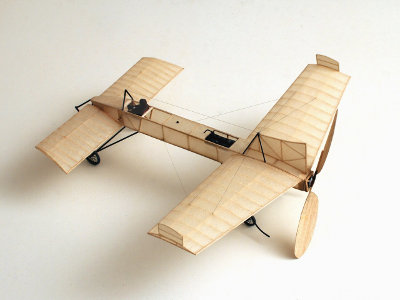|
||||
|
||||
|
||||||||||

|
Andrea Hartstein's lightweight Drzewiecki peanut can illustrate the differences between outdoor and indoor flying. Indoors it is an excellent flyer which can achieve flights of more than 90 seconds, but the one time it was tried outdoors it just floundered to the ground, in spite of near calm conditions. |
Wear old clothes to the flying site.
(AH) -Rubber power is a much lesser threat to clothes than oil spitting engines though!
Inspect rubber motors before going to the flying site and between flights.
(AH) -If one does not use a winding tube (or winds the rubber outside
the fuselage, as described by D.C.) this is especially important.
(DC) -I wind the rubber motor completely outside and away from the plane. I insert
it with a tool made out of a 3mm O.D. brass tube. There is a tiny wire hook
on the back of the motor that captures the rear peg. Sooner or later, the
body is exposed to the wound up motor, but so far, the motors have only
snapped outside the planes.
Check between flights to see that models are in one piece.
Provide hard points on models for handling and launching.
(AH) -Failure in this respect means repairs, and in consequence
a heavier and uglier plane.
To touch condenser paper is to tear it.
Condenser paper can't assist the framework to react any significant rubber motor torque.
Flailing and bunching rubber motors inside the fuselage shred condenser
paper covering.
(AH) -I have not experienced these troubles with condenser paper, but I have
not used the lightest type.
(DC) -Problems with condenser paper
surprised me also. Maybe I am really using the
ultralight stuff, I just grabbed it out of the box without sorting or
weighing it.
Too high a propeller pitch makes scale models impossible to trim.
(AH) -Yes, and the same is true for too large propeller diameter.
However, larger propeller means better performance so...
(DC) -On the subject of propeller size and pitch, I agree with your comments.
Besides experimenting with the propeller, I frequently have to enlarge or
reduce the vertical tail to get the desired flight trajectory.
The c.g. is around 25% because scale stabilizers are so small.
(AH) -I believe the optimum c.g. location varies with the type of plane, but
certainly a c.g. too far back will make the model impossible to trim.
If it flies in a totally inconsistent
pattern, one can always try to move the C.G further forward.
Provide means to adjust stabilizer and fin settings and to lock them in
place.
(AH) -To fasten rudder & elevator with just a few small drops of glue is one
way of achieving this. To use rudder hinges from soft aluminium (i.e drink
can material) is another. It pays to make separate ailerons too. Then one
doesn't have to use those unsightly trim-tabs!
Make the aft fuselage fat enough to allow room for the bunched up rubber
motor and for manipulating motors onto the rear peg.
(AH) -In scale models you can not change the fuselage cross section, so this
means that the rear motor peg must not be placed to far back. This is
also beneficial from the C.G point of view.
Use a non-climbing prop hook design.
(AH) -Allows the use of rubber motors much longer than the hook distance for
greater flight performance.
(DC) -My motors are around 3 1/2 time the hook to peg length, so
they can get kind of bulky in there as they unwind even though they are
tightly braided.
Although dead air can theoretically occur any time, outdoor flying can
most likely be done between 6 & 8 AM and 6 & 8 PM, if it can be done at all.
(AH) -In Sweden, flying pistachios or light-weight peanuts
outdoors is almost never possible. As said
above, it's only in the mornings and evenings that it is calm enough, but
then the air is humid and will cause warps. Heavier peanuts with doped
covering can however be flown outdoors on calm days.
Trimming models under part power is almost useless, because the propeller
thrust and torque are very predominant.
(AH) -I do not agree with this. I trim models beginning with low power,
not increasing until everything seems all right.
(DC) -I have often done the
build-up approach as you advocate only to run into radical changes of flight
characteristics under higher power which totally invalidate the initial test
results. This happens because the trim changes needed to control the higher
power reflect back into the performance in the lower power regime.
My views may be conditioned by the fact that I fly mostly outdoors,
with unlimited ceiling and no walls.
Models must be very securely boxed up for safe storage and transportation.
(AH) -Important! If one goes by bike or public communications, one must also
remember that the (possibly humid) outside air must not be allowed to enter
the box. Use a large and tight overlap between box and lid.
Check inventory the flying box before leaving for the flying site.
Take spares of any small things that may become lost.
(AH) -Yes, there's nothing more annoying than to reach the flying site and
discover that you have left some important piece of equipment at home.
|
|||||||